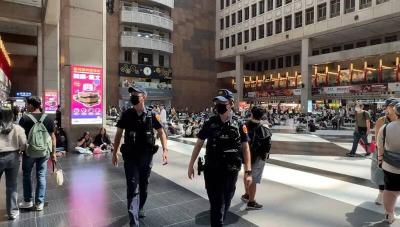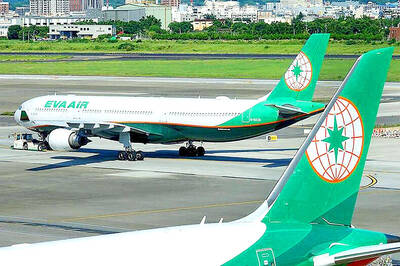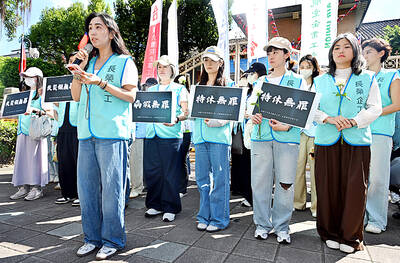A dozen former participants of the 1990s Wild Lily Student Movement (
"The wild lily we see now [at the National Taiwan Democracy Memorial Hall] is not the same as the wild lily of the student movement," said Ho Tung-hung (
The Wild Lily Student Movement was launched in the early 1990s in an effort to force changes in the then Chinese Nationalist Party (KMT) government.
Using a wild lily as a spiritual symbol, the movement drew tens of thousands of people -- mostly college students -- to what was known at the time as Chiang Kai-shek Memorial Hall to call for changes including dismissing the National Assembly, abolishing the Temporary Provisions Effective During the Period of Communist Rebellion (
"This is a wild lily that has been `green-ified,'" Ho said yesterday. referring to the hall's wild lily symbol, which features a green background.
"The real wild lilies are those that sprout independently all over the place," Ho said.
The decade-long wrangling between the DPP and the KMT has turned the two parties into two "huge national institutions" that plague the nation and its people, Ho said.
Many people are unable to express their opinions as "all of the channels are monopolized by the parties," he said.
Ho said it is very "ironic" for the DPP government to take the wild lily for its own use as a symbol of the hall because the DPP has forgotten that its opposition to the KMT's former authoritarianism was thanks to the participation of many people.
In response, Ministry of Education Secretary-general Chuang Kuo-jung (
"The symbol should not and does not belong solely to a certain group or party. It represents the will of the people," he said, adding the public must remember that the ministry and the DPP are separate entities and that the ministry does not speak for the party.
He said the pictures of the Wild Lily Student Movement are only a part of the human rights exhibit available in the hall right now. There is much more to Taiwan's democratic struggle than the student movement, he said.
Additional reporting by Jenny W. Hsu

A drunk woman was sexually assaulted inside a crowded concourse of Taipei Railway Station on Thursday last week before a foreign tourist notified police, leading to calls for better education on bystander intervention and review of security infrastructure. The man, surnamed Chiu (邱), was taken into custody on charges of sexual assault, taking advantage of the woman’s condition and public indecency. Police discovered that Chiu was a fugitive with prior convictions for vehicle theft. He has been taken into custody and is to complete his unserved six-month sentence, police said. On Thursday last week, Chiu was seen wearing a white

EVA Airways, one of the leading international carriers in Taiwan, yesterday said that it was investigating reports that a cabin crew manager had ignored the condition of a sick flight attendant, who died on Saturday. The airline made the statement in response to a post circulating on social media that said that the flight attendant on an outbound flight was feeling sick and notified the cabin crew manager. Although the flight attendant grew increasingly ill on the return flight, the manager did not contact Medlink — a system that connects the aircraft to doctors on the ground for treatment advice during medical

The Taoyuan Flight Attendants’ Union yesterday vowed to protest at the EVA Air Marathon on Sunday next week should EVA Airway Corp’s management continue to ignore the union’s petition to change rules on employees’ leave of absence system, after a flight attendant reportedly died after working on a long-haul flight while ill. The case has generated public discussion over whether taking personal or sick leave should affect a worker’s performance review. Several union members yesterday protested at the Legislative Yuan, holding white flowers and placards, while shouting: “Life is priceless; requesting leave is not a crime.” “The union is scheduled to meet with

‘UNITED FRONT’ RHETORIC: China’s TAO also plans to hold weekly, instead of biweekly, news conferences because it wants to control the cross-strait discourse, an expert said China’s plan to expand its single-entry visa-on-arrival service to Taiwanese would be of limited interest to Taiwanese and is a feeble attempt by Chinese administrators to demonstrate that they are doing something, the Mainland Affairs Council said yesterday. China’s Taiwan Affairs Office (TAO) spokesman Chen Binhua (陳斌華) said the program aims to facilitate travel to China for Taiwanese compatriots, regardless of whether they are arriving via direct flights or are entering mainland China through Hong Kong, Macau or other countries, and they would be able to apply for a single-entry visa-on-arrival at all eligible entry points in China. The policy aims